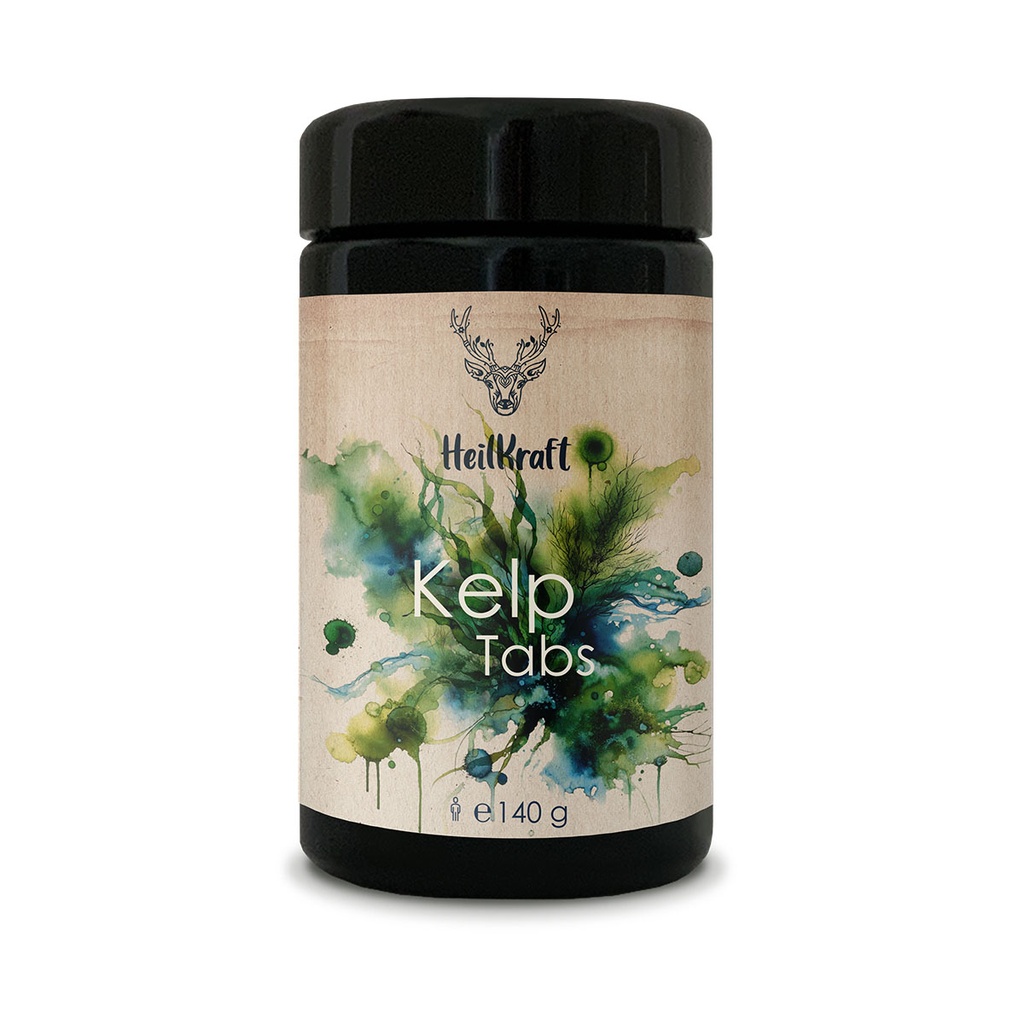Heilkraft Kelp Tabs
Kelp algae
On the plate almost every day in Asia, raw or steamed, but a rare food ingredient in Europe: seaweed. There are over 10,000 species worldwide, around 200 of which are edible. One of these is kelp - a great source of iodine and other micronutrients. You can find kelp algae at Heilkraft as 345 mg tablets with 150 µg iodine.
Our kelp tablets at a glance:
- 150 µg iodine and other important nutrients per tablet
- Pressed into small tablets
- Easy to dose
- 100% natural
- Packaged in high-quality Miron glass
What is kelp?
Kelp is the English term for seaweed, which has long since gained a foothold in German-speaking countries. The term is often used to describe brown algae or algae forests in general. In the case of our tablets, kelp stands for Ascophyllum nodosum - a brown algae of the order Laminariales, which is characterised by its particular resilience and rapid growth. Heilkraft Algae Tablets contain highly bioavailable iodine and other valuable vital substances.
Brown algae from the sea
Kelp algae are mostly found in cold areas of the oceans, but can also be found in the Baltic and North Seas. They owe their name brown algae to the fuxocanthin pigments, which drown out the green chlorophyll they contain and usually give the kelp a darker colour. Its Latin name Ascophyllum nodosum means "nodular tubular leaf". Its meaning becomes clear when you look at the distinctive long shoots of the algae. It has roundish, elongated nodes at almost regular intervals, which are wider in the centre and narrow again at the tips and serve the seaweed as swim bladders. The age of the kelp can be determined by the number of nodes: The first bladder grows in the third year, after which another one is added every year. Because of its appearance, kelp is also known as knotted kelp - similar to sea spaghetti, which is also known as reef kelp, or dulse - lobed kelp. In optimal conditions, kelp can grow to a length of two metres and live for 20 years.
Kelp ingredients
Ascophyllum nodosum is characterised by a particularly high proportion of natural iodine, but also contains many other important nutrients such as antioxidants, which is why our kelp tablets have a clear advantage over conventional mono-iodine preparations. The brown algae provide vitamins A and C as well as B vitamins, especially folic acid (B9) and B12. They also contain trace elements and minerals such as iron, potassium, sodium, copper, sulphur, calcium, magnesium and zinc. The algae polysaccharides, alginate and fucoidan are also important for the human body.
Algae as a dietary supplement
Kelp as a dietary supplement is available on the market in various forms. You can buy the algae extract as a powder, capsules or flakes. Passionate cooks can use the "sea vegetable" as a cooking ingredient for flavouring or as a tasty garnish. Kelp algae offers healing power in tablet form - practical and easy to dose, perfect for both travelling and daily intake.
Kelp algae: Iodine content & requirement
Iodine requirements vary throughout life. The amount of iodine required depends on age, but also on calorie metabolism and special metabolic requirements, such as during pregnancy and breastfeeding. Pregnant women need 230 micrograms of iodine a day and breastfeeding mothers 260 micrograms a day. The German Nutrition Society (DGE) recommends an intake of 200 micrograms for teenagers and adults up to the age of 50, and 180 micrograms a day for older people. Thanks to their high iodine content, our kelp tablets provide a natural and uncomplicated supply of iodine and have a decisive advantage over controversial, artificially iodised products such as iodised salt.
Are kelp algae plants?
Even though algae photosynthesise - i.e. use sunlight to grow - they are not plants. They have a much simpler structure than land plants, have no roots and no stem or stalk. Reproduction also works differently: while plants form seeds, algae reproduce mainly via cell division and spores. To put it simply, algae are simple, underwater organisms that biology categorises as protoctists, a separate kingdom between bacteria and even higher organisms: plants, animals and fungi. However, there is also another definition that divides plants into land plants and algae. This has to do with the fact that algae science emerged from botany, i.e. plant science. One thing is certain: the term "algal bloom" is misleading. The excessive growth of algae that is repeatedly observed in the world's oceans has nothing to do with "blooming". Algae do not have blooms.
Macro- and microalgae
Brown algae such as kelp are macroalgae, i.e. multicellular organisms that have plant-like structures and sometimes form extensive underwater forests. Around twenty species are used as food. However, microalgae such as spirulina or chlorella are also suitable as food supplements. These unicellular, microscopic algae are not recognisable to the naked eye, but are also bursting with vital nutrients. The marine superfood - whether micro or macro algae - contains more vitamins and minerals than most known land plants.
Ingredients
Kelp (Ascophyllum nodosum, ground), maltodextrin
Food supplement
Recommended dosage
Take 1 tablet daily unchewed with sufficient liquid.
Instructions
Do not exceed the recommended daily intake. Food supplements are not a substitute for a balanced, varied diet and a healthy lifestyle. In the case of thyroid disorders, consultation with a health expert is recommended.
Nutritional information
Contains | per tablet* | NRV** |
iodine | 150 µg | 100 % |
*Corresponds to one daily dose
**NRV: Percentage of the nutrient reference values according to Regulation (EU) No. 1169/2011.
Storage
Store closed, dry and protected from light at room temperature. Keep out of the reach of children.
Contents
140 g / 360 g

To install this Web App in your iPhone/iPad press
![]() and then Add to Home Screen.
and then Add to Home Screen.

